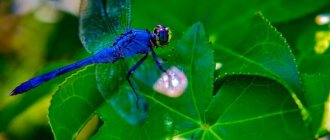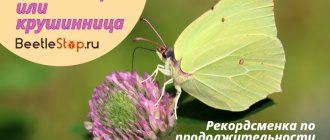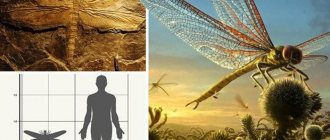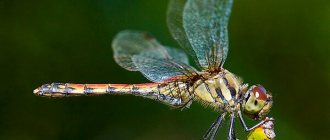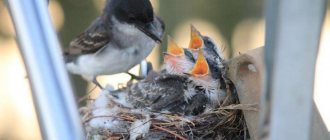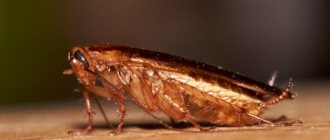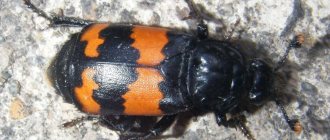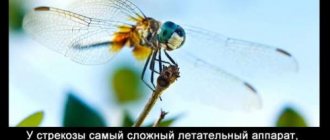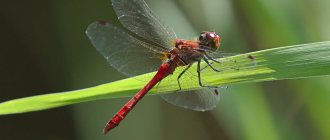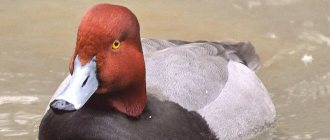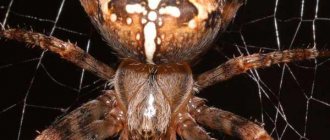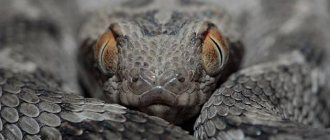Dragonflies are winged predators that captivate with their grace and beauty. They are one of the oldest amphibious insects that raise their offspring in an aquatic environment. The beautiful girl dragonfly is an amazing creature with a mother-of-pearl body and shiny wings. It is an excellent indicator of the cleanliness of a reservoir. If an insect has settled on its shore, then there is no chemical waste in the water.
Description
Length 45-48 mm, abdomen 34-38 mm, hind wing 30-31 mm, wingspan up to 70 mm. The male has no pterostigma. Body with a metallic sheen, blue with a green tint. The middle of the wing bears a wide metallic-shiny blue or dark blue band; the bases and apexes of the wing are colorless and transparent.
The female, instead of the pterostigma, has a light spot crossed by veins. The wings are almost colorless, with metallic shiny green cross-veins. The body is golden-green or bronze-green. The wings are relatively transparent, with a greenish tint and metallic shiny green cross-veins.
Habitats of sophisticated dragonflies
They live almost throughout the entire territory of Eurasia. These fragile creatures are found even beyond the Arctic Circle.
It lives near slow-flowing streams and small rivers, the banks of which are rich in riparian vegetation.
Most often, beauties stick to the banks of small bodies of water. They choose lakes, slow-flowing rivers, streams, and even swamps are suitable for them to live. The main condition is a sufficient amount of aquatic vegetation, since females lay eggs on plant stems.
Lifestyle
Adult beauties appear from May to September. In daylight they actively hunt, and at night they hide among plants. These dragonflies fly most readily on warm sunny days.
Males of beauties occupy home areas along the banks of reservoirs, and females often fly far from the water, appearing in whole flocks in places illuminated and well-warmed by the sun.
The beauty's flight is slow and uneven, but very maneuverable. She makes sharp turns, flies backwards and can even hover in one place like a helicopter. Deciding to rest, the dragonfly sits on a stalk or blade of grass. Its wings are folded with their upper planes inward or slanted back.
The beauty hunts insects in the air, grabbing them with the first pair of legs extended forward; its victims include all kinds of butterflies, beetles, flies, wasps and other dragonflies. The dragonfly often devours small prey on the fly, and deals with larger prey by sitting on some plant.
Insect lifestyle
Dragonflies are agile predators; their diet consists of small insects and invertebrates. They grab and eat prey on the fly. Adults are diurnal; they are most active on a clear sunny day. They spend the night sitting on bushes or tall grass. Summer period is from April to October. Females usually settle in forest clearings and fly to the banks of reservoirs to mate and lay eggs. Males choose coastal areas for themselves, where they live, hunt and wait for a partner for procreation.
Interesting fact. Dense vegetation is necessary for dragonflies not only for rest, but also for protection. Small insects with large wings are easily blown away by the wind.
The life of a beautiful girl dragonfly can be divided into two periods:
- Juvenile - begins after the imago emerges from the larval shell. It lasts about 10 days. The dragonfly actively feeds away from the reservoir until it acquires a characteristic color.
- Reproductive - having reached sexual maturity, insects return to water. Mating and egg laying occurs.
Dragonflies are insects with incomplete metamorphosis; their life cycle has three stages: egg, nymph, adult. Most of their life is spent in water - 2-3 years. The adult phase is much shorter - several months. Dragonflies are very shy; they fly into the air at the slightest noise or vibration in the air. Quick reaction saves insects from birds, amphibians and other enemies.
Nymph - predator in a pond
Dragonfly larvae are called nymphs; in appearance they differ significantly from adults. This is due to being in a different environment. Nymphs of beautiful girls prefer cool ponds with running water. Their body is elongated, brown in color, and their limbs are striped. Small predators eat fish eggs, mayfly larvae, mosquitoes, and small invertebrates. Nymphs are sensitive to water pollution; they survive only in clean water bodies. This is a kind of safety marker for a river or stream. In many countries of Central Europe, insects are listed in the Red Book. The lack of clean water bodies has threatened the existence of beautiful girls in Germany, Austria, and Switzerland.
Homoptera
There are three suborders of dragonflies. The first of them is Homoptera. It includes graceful, light and, as a rule, small insects with a very elongated abdomen. Both pairs of wings are identical in size and shape; when at rest, the dragonfly folds them at the back so that they form an acute angle with the surface of the back. Homoptera fly slowly and smoothly. Among them are such species of dragonflies as the graceful arrow, the beauty-girl and the dim lute. Homoptera nymphs living in water have a special respiratory organ located at the end of the abdomen - caudal gills.
SR Raffia Dragonfly Nymph
Hook: with a long shank, 2X - 4X, No. 8 - 10, in this case - TMS 200R No. 8
Mounting thread: brown, No. 6/0
Loading: thin lead tape or lead wire
Body and breast lining: mounting thread
Abdomen: raffia light or dark brown, depending on the natural color of the simulated larva
Legs: three pairs of hunting pheasant tail feather barbs glued together with mounting varnish or synthetic glue, natural coloring. There are three feather barbs on each leg. The joints are simulated by tying knots or bending the future leg with heated tweezers, followed by fixation with a drop of elastic varnish such as Dave's Flexament
Eyes: a piece of thick (0.5 - 0.8 mm) fishing line melted on both sides
Breast, head, wing rudiments: raffia light or dark brown, depending on the natural color of the simulated larva
Comment: all elements of the fly, made of raffia, require impregnation with elastic varnish. I prefer Dave's Flexament or Aquatex.
Tatyana Mityushina
Next in the selection of the most beautiful Russian girls is a Perm fashion model born in 1993. She won the hearts of viewers by starring in the Sports Illustrated Swimsuit Issue. The main theme of the magazine is the publication of fashion models in swimsuits against the backdrop of an exotic landscape. They say that an appearance in this publication guarantees the lucky girl the status of a supermodel in the future.
Whether this is true or not is still unclear; but so far Tatyana’s credits include filming in Victoria’s Secret and Intimissimi. And another sensation made in 2022 in Los Angeles. Then Tatyana appeared at the premiere of the film “John Wick 2” in an outfit with no underwear underneath. Thanks to this, the paparazzi were able to easily capture Mityushina’s bare breasts.
Variopterans and Anisozygoptera
The second suborder is heteroptera. They have a powerful body, and the base of the hind wings is widened. The eyes often touch. The flight speed of heteroptera is high. At rest, the wings of these dragonflies are spread apart. The larvae of dragonflies live in mud and breathe using rectal gills. It is worth mentioning some species of dragonflies belonging to heteroptera. This is an ordinary grandfather, a large rocker, a bronze headstock, and a blood dragonfly.
Representatives of the third suborder (Anisozygoptera) combine the characteristics of the first two, although in appearance they are closer to heteroptera. These dragonflies do not live in Russia.
Notes
- Shcherbak G. Y., Tsarichkova D. B., Verves Yu. G. Zoology of spineless animals: handbook: Book. 2. - K.: Libid, 1996. - 320 p.
- Shvanvich B.N. Course of general entomology: Introduction to the study of the structure and functions of the body of insects (Textbook for state universities) - M.-L.: “Sovetsk. science", 1949. - 900 s
- Bondarenko N.V., Polyakov I.Ya., Strelkov A.A. Harmful nematodes, mites, rodents. – L.: branch of the publishing house “Kolos”, 1969. – 272 p.
- Zakhvatkin Yu.A. Acarology - the science of ticks: History of development. Current state. Systematics: Textbook. - M.: Book house "LIBROKOM", 2012. - 192 p.
- Skvortsov V. E.
Dragonflies of Eastern Europe and the Caucasus: Key Atlas. - M.: Partnership of Scientific Publications KMK, 2010. - 624 p. — 1000 copies. — ISBN 978-5-87317-657-1. - ↑ Popova A. N.
Larvae of dragonflies of the fauna of the USSR (Odonata). — Keys to the fauna of the USSR, published by the Zoological Institute of the USSR Academy of Sciences. Issue 50. - M.-L.: Publishing House of the USSR Academy of Sciences, 1953. - P. 9-52. — 236 p. — 1500 copies. - Raikov B. E., Rimsky-Korsakov M. N.
Zoological excursions. - 6th. - L.: Uchpedgiz, 1956. - 694 p. - ↑ Kutikova L. A., Starobogatov Ya. I. (ed.).
Key to freshwater invertebrates of the European part of the USSR. - L.: Gidrometeoizdat, 1977. - P. 266-268. — 513 p. - Marlatt C. F. (1907). "The periodical cicada". Bulletin of the USDA Bureau of Entomology. 71:1-181
- Life of animals. Volume 3. Arthropods: trilobites, chelicerates, trachea-breathers. Onychophora / ed. M. S. Gilyarova, F. N. Pravdina, ch. ed. V. E. Sokolov. — 2nd ed. - M.: Education, 1984. - P. 215. - 463 p.
